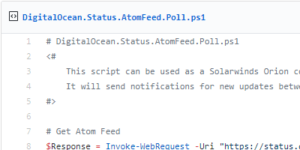
- #POWERSHELL WEBSITE MONITOR SCRIPT HOW TO#
- #POWERSHELL WEBSITE MONITOR SCRIPT INSTALL#
- #POWERSHELL WEBSITE MONITOR SCRIPT FULL#
- #POWERSHELL WEBSITE MONITOR SCRIPT FREE#
- #POWERSHELL WEBSITE MONITOR SCRIPT WINDOWS#
You can specify either a number to indicate the interval, in seconds, or a valid cron schedule format.įor information on writing PowerShell scripts, see Write scripts for the PowerShell input later in this topic. When you specify a script file (.ps1), prepend the script name with a period and a space (. The PowerShell command or script file to run. The Splunk platform uses the following stanzas in the nf file to monitor data gathered by PowerShell.
Restart the Splunk platform to enable the input. (Optional) Specify a schedule on which the command or script will run with the schedule setting. #POWERSHELL WEBSITE MONITOR SCRIPT FULL#
In the input, specify the command or the full path to your script with the script setting. #POWERSHELL WEBSITE MONITOR SCRIPT WINDOWS#
Open the nf file and edit it to enable a Windows PowerShell input. Create an nf configuration file in the %SPLUNK_HOME%\etc\system\local directory. On the Splunk platform instance that will run the script, open a PowerShell window. Write a PowerShell command or script to capture the information you want. See the Microsoft documentation on PowerShell for details.Ĭonfigure inputs with configuration files There might be additional requirements to run PowerShell scripts depending on the version of Windows and PowerShell. NET version 4.5 or higher must be installed on the machine. PowerShell version 3.0 or higher must be installed on the machine. The Splunk platform instance must be configured to use the Local System user to run all PowerShell scripts. #POWERSHELL WEBSITE MONITOR SCRIPT INSTALL#
See Install on Windows in the Installation Manual.
The Splunk platform instance must run on Windows. Splunk Cloud Platform must receive Windows data that comes from PowerShell scripts from a universal forwarder that is installed on a Windows machine. If you use Splunk Cloud Platform and want to monitor script output, use the universal forwarder to ingest the output from a Windows machine and forward it to your Splunk Cloud Platform deployment. The Splunk platform then indexes the output of these commands or scripts as events. You can use the PowerShell input to run a single PowerShell command or reference a PowerShell script. The Splunk platform supports monitoring events received through PowerShell scripts. You can create scripts with the language and output the results of those scripts as objects to other scripts. It lets you handle Windows operations from a command-line interface. PowerShell is a scripting language that comes with many versions of Windows. #POWERSHELL WEBSITE MONITOR SCRIPT FREE#
Thanks for reading, please feel free to post any questions or comments below.Monitor Windows data with PowerShell scripts
GitHub CLI | Take GitHub to the command line. Automate administrative tasks by using PowerShell – Training | Microsoft Learn. If you would like to learn more, review the following resources: In the future, it would be ideal if environments could be managed using the GitHub CLI. The GitHub CLI was used to obtain an access token and the GitHub REST API was used to create the environment. In this post, I demonstrated the simplest way to create a GitHub environment using PowerShell. The Deployment environments API provides the capability to create, configure, and delete deployment environments. Invoke-WebRequest -Method PUT -Header $header -ContentType $contentType -Uri $uri $uri = "$owner/$repo/environments/$envName" 
$envName = "Development" # The name of the environment

$repo = "RapidBlazor" # The name of the repository Create an environment using the following commands: $owner = "JasonTaylorDev" # The account owner of the repository The simplest way to interact with the GitHub REST API from PowerShell is to use the Invoke-WebRequest utility. Once authenticated you can obtain an access token using the following command: gh auth token Create an environment Once installed, authenticate with GitHub using the following command: gh auth login If you need to install the GitHub CLI, follow these instructions. The simplest approach is to use the GitHub CLI. In order to create an environment, you will first need to authenticate with GitHub and obtain an access token.

#POWERSHELL WEBSITE MONITOR SCRIPT HOW TO#
In this post, I will demonstrate how to create environments using PowerShell. If you would like to automate the management of environments, such as within a PowerShell script, the best approach is to use GitHub REST API. Currently, there are two ways to manage environments – using (see Settings > Environments) or using the GitHub REST API. GitHub deployment environments are used to describe a general deployment target such as development or production.







 0 kommentar(er)
0 kommentar(er)
